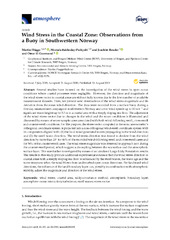| dc.contributor.author | Flügge, Martin | |
| dc.contributor.author | Bakhoday Paskyabi, Mostafa | |
| dc.contributor.author | Reuder, Joachim | |
| dc.contributor.author | El Guernaoui, Omar | |
| dc.date.accessioned | 2020-03-31T11:13:23Z | |
| dc.date.available | 2020-03-31T11:13:23Z | |
| dc.date.issued | 2019-08-26 | |
| dc.Published | Flügge M, Bakhoday-Paskyabi M, Reuder J, El Guernaoui O. Wind Stress in the Coastal Zone: Observations from a Buoy in Southwestern Norway . Atmosphere. 2019;10(9):491 | eng |
| dc.identifier.issn | 2073-4433 | en_US |
| dc.identifier.uri | https://hdl.handle.net/1956/21637 | |
| dc.description.abstract | Several studies have focused on the investigation of the wind stress in open ocean conditions where coastal processes were negligible. However, the direction and magnitude of the wind stress vector in coastal areas are still not fully known due to the low number of available measurement datasets. Here, we present new observations of the wind stress magnitude and its deviation from the mean wind direction. The data were recorded from a surface buoy during a five-day measurement campaign in southwestern Norway and cover wind speeds up to 10 m s−1 and significant wave heights up to 3.5 m in a coastal area with a steeply sloping sea floor. The adjustment of the wind stress vector due to changes in the wind and the wave conditions is illustrated and discussed by means of seven sample cases associated with both wind-following swell, cross-swell and counter-swell conditions. For this purpose, the stress vector computed in the sonic anemometer’s orthogonal coordinate system is projected into a non-orthogonal wind-swell coordinate system with its components aligned with: (1) the local wind-generated waves propagating in the wind direction; and (2) the swell wave direction. The wind stress direction was found to deviate from the wind direction by more than 20° for 46% of the recorded wind-following swell and cross-swell cases and for 54% of the counter-swell cases. The wind stress magnitude was observed to approach zero during the counter-swell period, which suggest a decoupling between the sea surface and the atmospheric surface layer. This was further investigated by means of an idealized Large Eddy Simulation results. The results in this study provide additional experimental evidence that the wind stress direction in coastal areas with a steeply sloping sea floor is influenced by the swell waves, the wave age and the wave steepness when the wind blows from undisturbed open ocean directions. For landward wind directions, the influence of the land boundary layer can, possibly in combination with atmospheric stability, adjust the magnitude and direction of the wind stress. | en_US |
| dc.language.iso | eng | eng |
| dc.publisher | MDPI | en_US |
| dc.rights | Attribution CC BY | eng |
| dc.rights.uri | https://creativecommons.org/licenses/by/4.0/ | eng |
| dc.subject | wind stress | eng |
| dc.subject | coastal area | eng |
| dc.subject | eddy-covariance method | eng |
| dc.subject | atmospheric boundary layer | eng |
| dc.subject | atmosphere–ocean interaction | eng |
| dc.subject | Turbulence | eng |
| dc.subject | swell waves | eng |
| dc.subject | stress vector | eng |
| dc.title | Wind Stress in the Coastal Zone: Observations from a Buoy in Southwestern Norway | en_US |
| dc.type | Peer reviewed | |
| dc.type | Journal article | |
| dc.date.updated | 2020-01-29T14:38:35Z | |
| dc.description.version | publishedVersion | en_US |
| dc.rights.holder | Copyright 2019 The Author(s) | en_US |
| dc.identifier.doi | https://doi.org/10.3390/atmos10090491 | |
| dc.identifier.cristin | 1733248 | |
| dc.source.journal | Atmosphere | |
| dc.relation.project | Norges forskningsråd: 227777 | |
| dc.relation.project | Universitetet i Bergen: Bergen Offshore Wind Centre (BOW) | |
| dc.relation.project | Notur/NorStore: NN9506K | |
| dc.relation.project | Norges forskningsråd: 193821 | |

